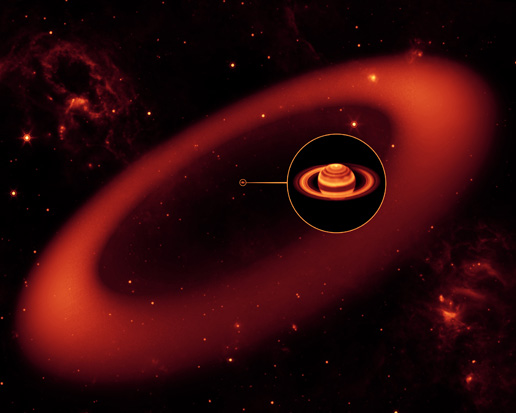The Spitzer Space Telescope discovered Saturn's largest ring, which shines with infrared light, and reflects almost no visible light, due to its sparseness

The Spitzer Space Telescope discovered Saturn's largest ring, which shines with infrared light and reflects almost no visible light. This is a surprising ring, says Ann Versbicker, an astronomer at the University of Virginia. "If you could see the ring in the night sky (from Earth's distance), it would cover twice the area of the full moon. Verbisker is a co-author of an article about the discovery that should be published today, Thursday, in the journal Nature. The other researchers involved in the study are Douglas Hamilton from the University of Maryland and Michael Skrotsky from the University of Virginia.
The new belt is far from the center of the Saturn system, and its orbit is tilted 27 degrees from the main plane of the rings. Its main mass starts at a distance of about 6 million km from the planet and extends to a distance of 12 thousand km. It would take about a billion earths together to fill the ring. One of Saturn's most distant moons, Phoebe, orbits Saturn inside the new ring, and is probably also the source of the material the ring is made of.
This is a thin ring, containing extremely dispersed ice and dust particles. Spitzer's infrared eyes were able to detect the glow of the cold dust, whose temperature is extremely low at about 80 degrees Kelvin. The discovery may solve one of the oldest mysteries about one of Saturn's moons. Iapetus has a strange appearance - one side of it is light and the other extremely dark, in a pattern reminiscent of the yin-yang symbol. Astronomer Giovanni Cassini first discovered the moon in 1671 and years later discovered that it has a dark side, now the formation is called the Cassini region in his honor.
Saturn's surprising ring explains how the Cassini region became so dark. The ring orbits Saturn in the same area as Phoebe, while Iapetus, the other rings and most of Saturn's moons move in the opposite direction. According to the scientists, some of the dark matter from the outer ring moved inward toward Iapetus, colliding with the icy moon like flies on a car window.
"Astronomers have long suspected a connection between the outer moon Phoebe and the dark matter on Iapetus," Hamilton said. "This ring provides the missing link."
The ring is barely visible in visible light. The relatively small amount of particles in the ring reflects little light, especially in the Saturn region, where solar radiation is weak. "The particles are so far apart that if you stand inside the ring, you won't know it," says Verbisker. "By focusing on the glow of the ring's cold dust, Spitzer was able to locate it easily."

8 תגובות
It's hard to see it here, but so be it
good week
Yehuda
Yehuda:
I already explained to you in response 3 that Saturn is in the center here as well.
He is simply so small that they drew a line from him and drew a circle with his enlargement inside.
According to the data in the article, the radius of the ring is almost a hundred times larger than the radius of Saturn.
If you could recognize Saturn in the picture you saw - most likely its scale was wrong.
In yesterday's lecture at the Givatayim Observatory, where Avi Blizovsky was also present, they showed another artist's picture of this ring, more accurate in which Saturn appeared in the center of the new ring.
Every artist and his work is.
good evening
Sabdarmish Yehuda
If it is an artist painting then that explains all the deviations
Yehuda
By the way, an artist's perception is not the result of a photograph and in relation to the position of Saturn in the center - it should be noted that the drawing of Saturn is actually an enlargement or even a "reading" of a very small point in the center of the ring.
Saturn is actually very close to the center of the ring and it is written in the article that:
"One of Saturn's most distant moons, Phoebe, orbits Saturn inside the new ring, and is probably also the source of the material the ring is made of."
It has nothing to do with the angle of the other rings because the current ring is tilted compared to them.
Since Saturn is currently at an angle where it is impossible to distinguish its rings, it can be assumed that this photo was taken a long time ago, and note that Saturn will not be in the center of the new ring. Maybe the ring is from some comet whose tail was caught in the planet's gravity?
Food for thought.
Good night
Sabdarmish Yehuda